Vitality through time and space is the ultimate yardstick for measuring the value of music.
Popular songs are easier, but also less valuable
Wen| Gan Lei, the first voice of music
So-called hit songs at the data level seem to be getting easier and easier.
Recently, a statistic released by Chartmetric shows that more and more songs are released to exceed 1 billion views on Spotify in the short term.
In 2016, rapper Drake’s song “One Dance” became the first song on Spotify to reach 1 billion views 193 days after its release, creating an industry myth at the time. In less than two months since New Year’s Day in 2025, 34 songs have successfully entered Spotify’s Billion ‘s Club list.
There is no doubt that the cumulative 1 billion views is indeed a major milestone in the commercial success of music. However, as data continues to inflate, does it mean that the threshold for success in streaming media is getting higher and higher? Does the explosion in data mean the true vitality of music works?
“An accelerating era of billion views
In the early days of streaming media development, reaching the milestone of one billion views was still rare.
According to statistics, Spotify ‘s Billion Club currently has 875 songs, and it continues to increase. The songs bridge generations, including classic hits from the 1970s and 1980s, and new charts that reached landmarks in just a few months.
Grouped by release year, it can be clearly seen that songs released in 2015 took an average of 2621 days (i.e. 7.2 years), which means that it will not reach 1 billion views until around 2022; while songs released in 2020 only took an average of 1085 days (i.e. 2.9 years), and by 2024 this time will be shortened to an average of 180 days (i.e. 0.5 years).
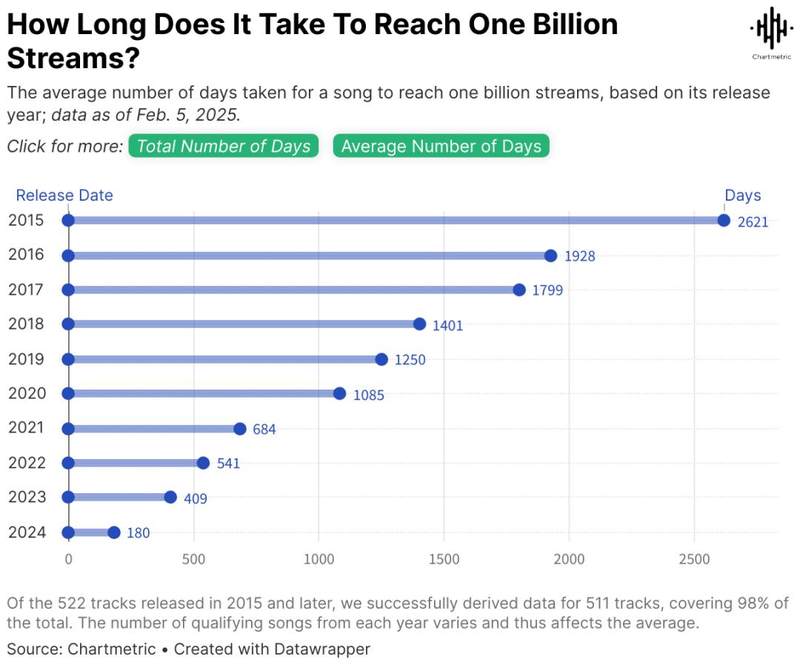
Obviously, with the rapid development of streaming media, it is no longer a myth that the number of views exceeded 1 billion, and the speed record is constantly being refreshed.
For example, in May 2023, Miley Cyrus’s “Flowers” reached 1 billion views in just 112 days after its release on Spotify, setting a record at the time. But in October of the same year, this record was broken by Jung Kook and Latto’s collaboration on “Seven”, which took only 108 days to reach 1 billion views. A year later, Lady Gaga and Bruno Mars ‘song “Die With A Smile” reached 1 billion views in just 96 days, setting a new record again.
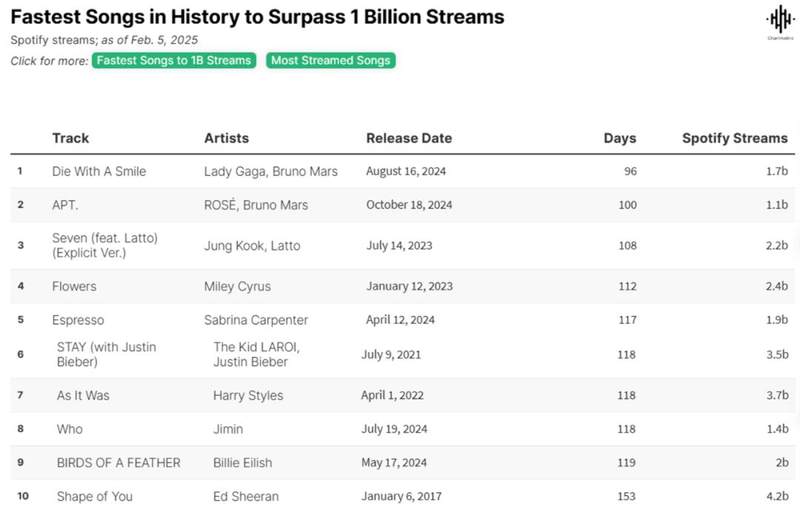
Looking at the songs released each year with 1 billion views, we can find that the time gap between the fastest and slowest songs is gradually narrowing. Among the songs released in 2022, all songs with 1 billion views will achieve this data target in less than 1000 days; by 2024, this time will be shortened to less than 300 days, and the fastest and slowest songs will have a negligible difference in time, breaking into the billion club within a highly compressed time range.
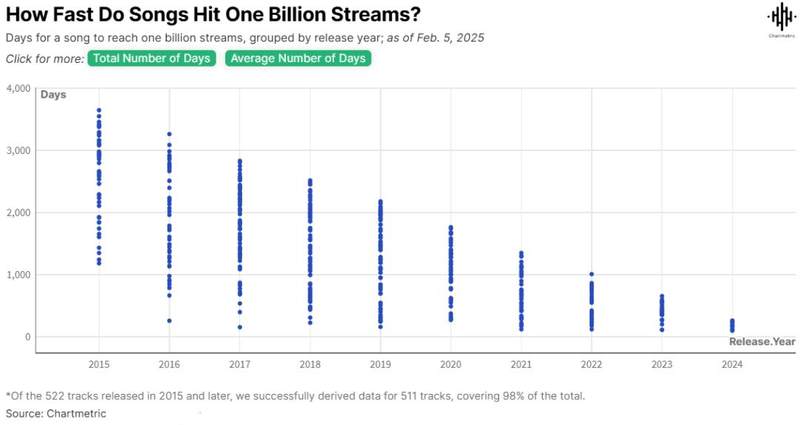
In terms of the number of songs, since “One Dance” exceeded 1 billion views for the first time in 2016, the number of songs exceeding 1 billion every year has increased like a snowball. In 2019, 31 songs entered the Billion Club list, an explosive increase from 7 songs the previous year, and in 2020, this number jumped to 68 songs. In the next few years, the growth trend remained strong. By 2024, 296 new songs have exceeded 1 billion views on Spotify.
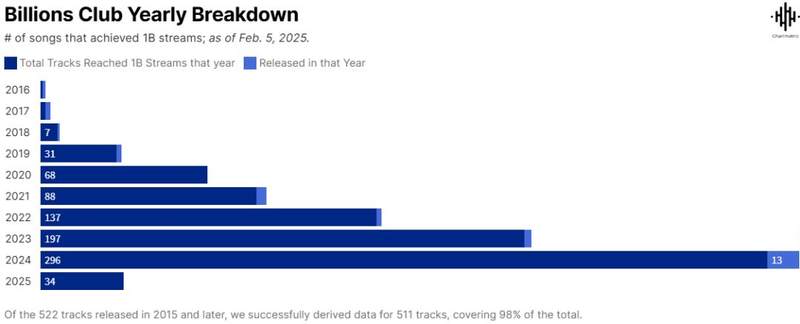
It is worth noting that among the songs that exceeded 1 billion played between 2016 and 2023, the proportion of new songs released that year was extremely low, reaching a relative peak of 4 songs in 2021. However, in 2024, 13 songs exceeded the 1 billion playback mark in the year of release, indicating that the streaming media market has begun to shift from a long tail effect to an instant hit model.
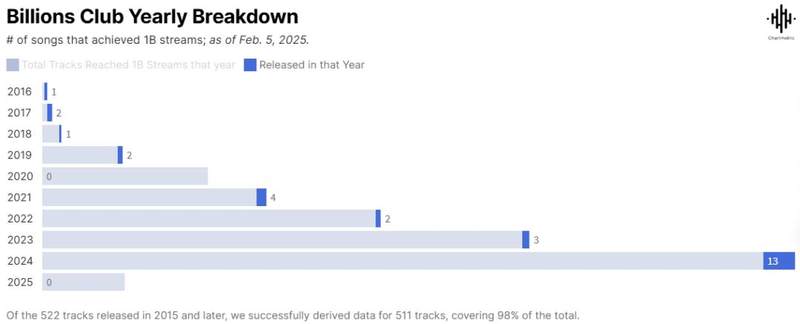
Driven by the long-term factor, streaming media platforms seem to be getting stronger and stronger, but their value also seems to be weakening.
User Base, Algorithm Mechanism and Multiple Drivers of Short Video
Data is not only the result, but also the means of production that drives communication.
The number of songs played quickly exceeded the 1 billion mark, and a major driving force behind it was the rapid growth of the platform’s user base. As of the fourth quarter of 2024, the number of monthly active users of Spotify has reached 675 million, covering 184 countries and regions around the world, of which 263 million paid subscription users have reached. The huge user base has laid a solid foundation for the rapid spread of songs, and the parallel dual-track mechanism of editorial recommendation and algorithm-driven has built a key channel for popular songs to become popular.
As we all know, top song lists such as Today ‘s Top Hits and New Music Take Today ‘s Top Hits song list as an example, which ranks at its peak in traffic with 35.2 million followers. Looking further at the content of the song list, it is not difficult to find that there is a significant overlap between it and the billion-club song list. Phenomenal songs such as “Die With A Smile” and “APT” that rank among the billion-club clubs are almost always a frequent visitor to today’s popular list.
Algorithms are also an important booster. As early as July 2015, Spotify launched the Discover Weekly personalized recommendation feature. Matt Ogle, then Spotify product manager, once said that the accuracy of the Discover Weekly recommendation mechanism benefits from the so-called Cyborg Approach, which builds machine algorithms on individual user behaviors and relational networks. An important manifestation of this is the Collaborative Filtering mechanism in Spotify’s recommendation algorithm, which recommends other songs that similar users like.
Under the collaborative filtering mechanism, whether a song can be recommended by the platform depends largely on the common choice of most users. The algorithm builds a prediction model in real time by tracking user behavior (such as skip rates, playback completion levels, number of song loops, etc.). Once a work enters the recommendation pool, it spreads through weekly discoveries, today’s hottest lists, etc., and even drives the Matthew effect, making popular songs even hotter.
On July 9, 2024, Spotify officially added a podcast comment area function, which officially transformed the social network hidden behind the algorithm into an explicit interactive field. In contrast, domestic platforms represented by Netease Cloud Music have long regarded social ecology as their main feature, and were even famous for their emotional tree holes in the early days. It is worth noting that domestic streaming media does not directly disclose the number of songs played, but users have spontaneously formed a popularity measurement system based on 999+comments, which confirms the deep coupling between traffic and social interaction.
This coupling relationship is more vividly reflected in the era of Short Video.
Data shows that of the 14 songs with a billion views on Spotify in 2024, 12 have sparked a craze on TikTok. Singer Tommy Richman’s phenomenal single “MILLION DOLLAR BABY” is a vivid example.
On April 14 last year, Tommy Richman released a short warm-up video on TikTok, which took the lead in becoming popular; then the song was officially released on April 26, successfully diverting listeners to the streaming media platform to search and listen. More than 10 million TikTok posts used “MILLION DOLLAR BABY” as the soundtrack, successfully boosting the number of views on Spotify to exceed 1 billion.
It can be seen from a review that the fragmented spread of Short Video forms a flow reservoir, and the flow is reversed through precise guidance, forming a complete transmission link from auditory memory-active search-data precipitation.
Another example is “APT.” collaborated by ROS and Mars Brothers. Through a large number of dance creations, it generated more than 9 million posts on TikTok, and exceeded 1 billion views on Spotify in just 100 days after its release, setting a new record for the transformation from a social hotspot to a top streaming stream. Similar to the former, the social fission based on the user’s secondary creative behavior injects strong communication momentum into the work; and the real-time feedback from streaming media lists and social popularity further builds an enhanced loop of data mutual feeding, pushing the song to the critical point of phenomenal communication.
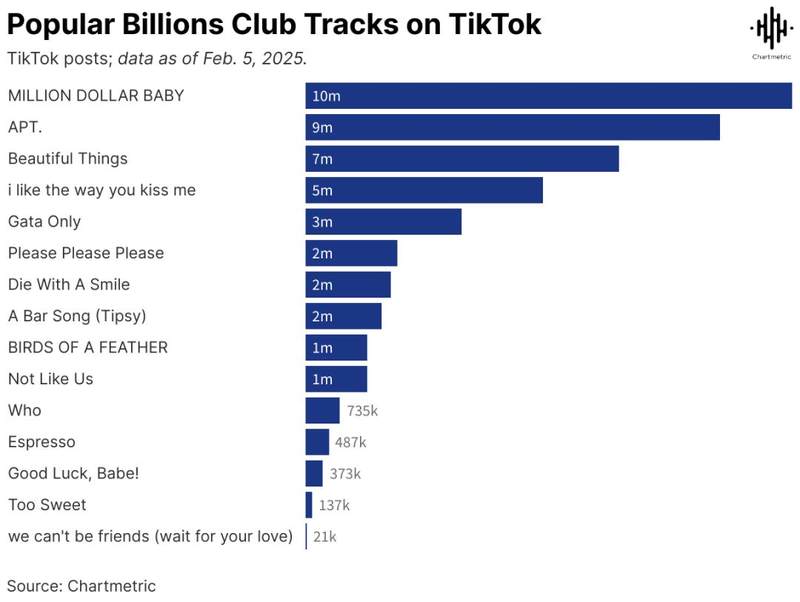
These cases show that today’s music communication has evolved into a collaborative operation between user base, algorithmic mechanisms and the social ecosystem of Short Video.
Behind data inflation: Exploring the yardstick for measuring the value of music
It is undeniable that driven by multiple factors such as users, algorithms and Short Video, music streaming is experiencing inflation in data indicators, and the threshold for success in streaming media has also risen.
According to Chartmetric data, the average number of songs on the Spotify platform that exceed 1 billion streaming views usually stabilizes at around 1.5 billion, while the order of 2 billion constitutes a new watershed. Currently, only 47 songs have exceeded this threshold.
It can be expected that 1 billion views will no longer be the ultimate indicator of the success of songs in streaming media in the future. 2 billion and 3 billion clubs will soon become the new yardstick for measuring top works.
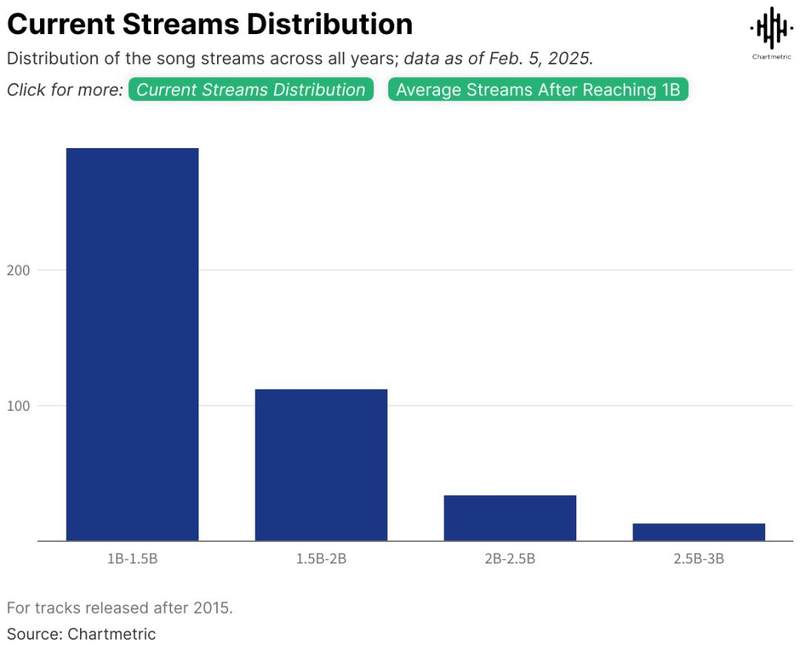
The data inflation trend of domestic music platforms is equally significant. The number of songs with NetEase’s cloud music reviews exceeding 100,000 + is about to exceed 1,000, and the number of song collections exceeding one million has become a new benchmark. The 999+ comment logo that once symbolized phenomenal popularity is gradually eclipsing. What is even more worrying is that some short-term marketing techniques and deliberately created controversial or battle-fuelling topics can often generate a large number of song reviews and create a false hit scene.
If you turn your perspective to the music itself, the value paradox hidden behind the data bubble will gradually surface.
It is not difficult to find that today’s TikTok Hot Topic Challenges often try to create 1 billion views for a certain new song in a short period of time. It took Earth, Wind Fire 44 years for “September” in 1978 to join the 1 billion club. Elvis Presley’s “Can t Help Falling in Love” released in 1961 took 63 years to achieve this statistical achievement. When faced with classic works, this simple numerical comparison obviously loses its meaning.
The influence of classic works before the streaming media era has been accumulated and repeatedly sung through multiple channels such as on-demand radio, physical record sales, and film and television works implantation, completing cross-generational cultural penetration. Veteran music journalist Jubran Haddad pointed out that if there was a way to transform the influence of these works in their heyday into contemporary streaming media indicators, they would likely exceed 1 billion views faster than most of today’s hot songs. rdquo;
In this sense, the criteria for measuring the popularity of songs should be more diversified and refined, including physical sales, social media interactions, secondary derivatives of Short Video platforms, offline performance conversion rates, etc. In essence, the vitality of music should depend on whether it can resonate with human nature in the torrent of the times. The true evergreen works are by no means a mere accumulation of data, but a cultural totem forged by fans and the community.
We believe that truly vital music works will not be afraid of the dissipation of the data traffic bubble. From radio hits in the vinyl era to hot song lists and Short Video BGM in the streaming era, they will find new ways to take root in the cultural soil of different eras.
This vitality that travels through time and space is the ultimate yardstick for measuring the value of music.
It is not allowed to reproduce at will without authorization, and the Blue Whale reserves the right to pursue corresponding responsibilities.



